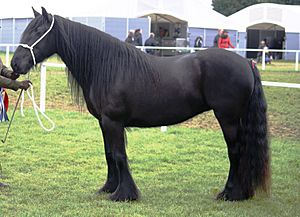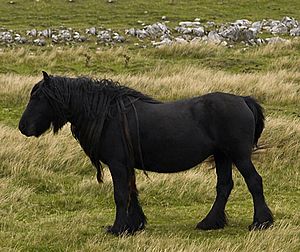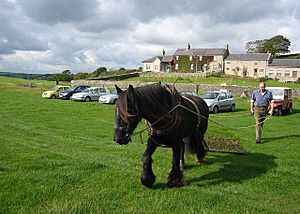Dales pony facts for kids

Dales Pony
|
|
| Country of origin | England |
|---|---|
| Breed standards | |
| Dales Pony Society | Breed standards |
| Horse (Equus ferus caballus) | |
The Dales pony is a special type of horse from the United Kingdom. It is one of the native mountain and moorland pony breeds. These ponies are famous for being strong, tough, and brave. They are also very smart and have a good temper.
The Dales pony's story is closely tied to lead mining in the Dales area of Yorkshire. They were originally working ponies. A special group, called a breed registry, was started in 1916 to keep track of them.
These ponies were used a lot by the British Army in both World Wars. After the Second World War, there were very few Dales ponies left. But people worked hard to save them. Today, they are used for many fun activities. However, there are still not many Dales ponies. Because of this, groups like the Rare Breeds Survival Trust and The Livestock Conservancy say they are "critical" or "threatened."
- Type: Native Pony
- Colours: Black, Brown, Bay, Grey, and Roan
- Size: Usually 14 hands (142.2 cm) to 14.2 hands (146.2 cm) tall.
Contents
What Makes a Dales Pony Special?
Looks and Build
Dales ponies are usually about 14 to 14.2 hands (56 to 58 inches, 142 to 147 cm) hands tall. Their heads are neat and wide between the eyes. They have a fine muzzle and ears that curve inward.
Their bodies are strong and muscular. They have a deep chest and powerful hindquarters. Their necks are well-built and join smoothly into strong withers and shoulders.
The legs of a Dales pony are very strong. They have hard bones and clear tendons. Their hooves are large and round. They also have long, silky hair on their manes, tails, and lower legs, called feathers.
Colours and Markings
Most Dales ponies are black. But you can also find them in brown, bay, grey, and roan.
They are not allowed to have many white markings. Only a small white spot (a star) or a small stripe (a snip) on their head is okay. White on their legs should not go above the fetlock joint.
Movement and Temperament
A Dales pony moves with lots of energy and power. They lift their hooves well off the ground. Overall, they look alert and brave, but also calm and kind.
If a Dales stallion breeds with a non-Dales mare, the foal can be registered as a part-bred. However, if a Dales mare breeds with a non-Dales stallion, the foal cannot be registered. This rule helps keep the purebred Dales pony population strong.
The Dales Pony Story
Early History and Mining Work
Horses have lived and worked in the Dales area for a very long time. Horse bones from Roman times have been found there. The Romans even called a local tribe the 'Gabrantovici,' meaning 'horse-riding warriors.'
The modern Dales pony's history is closely tied to lead mining in England. Lead has been mined in this area since Roman times. Lead, iron ore, and fuel were all carried by pack ponies. Each pony could carry up to 240 lb (110 kg) of goods!
These pack pony trains could have up to 20 ponies. They often worked 'loose,' meaning they weren't led by a rope. One person on horseback would supervise the whole train.
How the Breed Developed
The Dales pony we know today comes from several different breeds. The first working ponies were a mix of Scottish Galloway ponys and local Pennine pony mares in the late 1600s.
Later, in the 1700s, Norfolk Cob horses were added to the mix. Many Dales ponies today can trace their family tree back to a famous horse called the Darley Arabian. This horse was also one of the main fathers of the modern Thoroughbred racehorse.
Clydesdale, Norfolk Trotter, and Yorkshire Roadster horses were also added. This helped improve the Dales pony's trotting ability. In the 1800s, the Welsh Cob stallion Comet was used to make the Dales ponies bigger. This is why the two breeds look a bit alike.
Dales ponies were fast and strong. They did very well in trotting races in the 1700s. They were also used in organized hunts. Even into the early 1900s, Fell ponys and Dales ponies sometimes mixed.
Saving the Breed
In 1916, the Dales Pony Improvement Society was formed. They started a stud book to keep track of purebred Dales ponies. This happened because adding Clydesdale blood was starting to change the Dales ponies too much.
The British Army bought many Dales ponies in the early 1920s. They wanted only the best ones. These ponies had to be strong, between 14.0 and 14.2 hands tall, and able to carry heavy loads in mountains.
During the Second World War, the Dales pony almost disappeared. Many ponies were taken for army work or to pull wagons in towns. After the war, many ponies used by the military were left behind or even killed for food.
By 1955, only four new female Dales ponies were registered. It was a very low number! But a small group of breeders worked hard to save them. They looked for unregistered ponies that still looked like the original Dales type.
In the 1960s, three Fell pony stallions were bred with Dales mares to help increase the numbers. The Dales Pony Society was reorganized in 1964. They also started a "Grading-Up Register" to find and breed ponies that had the old Dales characteristics.
This program worked! By 1971, there were enough Dales ponies that the program stopped. By the 1990s, the population grew even more. Some ponies were even sent to Canada and the US. In 1999, there were about 60 registered ponies in North America and 800 worldwide.
Today, the Dales pony is still considered "critical" by the Rare Breeds Survival Trust in the UK. This means there are fewer than 300 breeding females. The US-based Livestock Conservancy calls the breed "threatened." This means there are fewer than 5,000 worldwide.
Health of Dales Ponies
Dales ponies can carry a serious genetic disease called foal immunodeficiency syndrome (FIS). This disease is recessive, meaning a foal only gets sick if it inherits the gene from both parents.
Foals with FIS look normal at birth. But their immune system doesn't work well, and they have anemia. This leads to infections that cannot be treated, and they usually die within three months.
In 2010, a genetic test was created for FIS. It showed that 12% of Dales ponies in the UK were carriers of the gene. Now, breeders can test their ponies. They can avoid breeding two carrier animals together. This helps prevent foals from getting the disease.
What Dales Ponies Do Today
Today, Dales ponies are used for many fun activities. They compete in show jumping, cross-country, dressage, driving, and eventing.
Their calm and kind nature makes them great for endurance riding and trekking holidays. They can carry both new and experienced riders, adults or children, over all kinds of land for long distances.
Small groups of Dales ponies still live freely in the eastern Pennines. In 2007, there were about 30 breeding mares in these wild herds.




